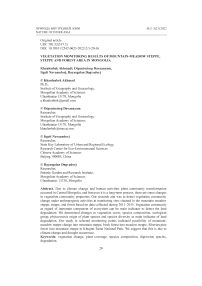Vegetation monitoring results of mountain-meadow steppe, steppe and forest area in Mongolia
Автор: Khaulenbek Akhmadi, Otgontsetseg Davaanyam, Itgelt Navaandorj, Bayasgalan Dagvadorj
Журнал: Природа Внутренней Азии @nature-inner-asia
Рубрика: Биология
Статья в выпуске: 2-3 (21), 2022 года.
Бесплатный доступ
Due to climate change and human activities plant community transformation occurred in Central Mongolia, and however it is a long-term process, there are some changes in vegetation community properties. Our research aim was to detect vegetation community change under anthropogenic activities at monitoring sites situated in the mountain meadow steppe, steppe, and forest based on data collected during 2011-2015. Vegetation community as regard of important component of ecosystem can be main indicator to detect the land degradation. We determined changes in vegetation cover, species composition, ecological group, phytocenosis origin of plant species and species diversity as main indicator of land degradation. Our study in selected monitoring points indicated possibility of mountain-meadow steppe change into mountain steppe, birch forest into meadow steppe, Siberian pine forest into mountain steppe in Khugnu-Tarna National Park. We suggest that this is due to climate change and drought occurrence.
Vegetation change, plant coverage, species composition, digression species, degradation
Короткий адрес: https://sciup.org/148325684
IDR: 148325684 | УДК: 581.52(517.3) | DOI: 10.18101/2542-0623-2022-2/3-20-36
Текст научной статьи Vegetation monitoring results of mountain-meadow steppe, steppe and forest area in Mongolia
During the last three decades, the mean summer air temperature significantly increased by 2.5°C [Vandandorj et al., 2017] and precipitation has decreased by 8.7% to 12.5% in the central and Gobi areas of Mongolia during last 70 years [Natsagdorj & Altantsetseg, 2008]. There were several evidences to illustrate dryness has been persisting in Mongolia [Natsagdorj et al., 2019] and aridity is likely to increase in the central part of the Mongolia during the twenty-first century [Natsagdorj & Gomboluudev, 2015; Mandakh et al., 2018].
Additionally, in the last decade, the total number of livestock one of the leading factors to land degradation had increased almost 2 times (32.7 million in 2010, 70.9 million in 2019) in Mongolia whereas the amount of pasture land decreased gradually due to it turn into other use1. Consequently, availability for seasonal rotation of pasture is in deficit for herders and it is becoming difficult to keep the rangeland free from grazing pressure. Many research results illustrated that the rapidly increased animal load in the past decades has disrupted the natural balance [Bazha et al., 2012; Bulgamaa et al., 2018] in semiarid and arid ecosystems with high vulnerability to degradation and desertification of Mongolia2. Plant encroachment resulted to pasture degradation due to overgrazing is observed regularly in semi-arid and arid land of Mongolia [Chognii, 2001; Bazha et al., 2012].
As a result of the continuous increase of the anthropogenic load including grazing pressure and repeated droughts in Central Mongolia during the past 20 years, the transformation of the vegetation communities in some ecosystems occurred, therefore the role of native edificators became insignificant or they completely disappeared from the phytocenosis in such changed communities [Bazha et al., 2008, 2012). In the Central Mongolia, this phenomenon was observed in several vegetation communities including steppe, dry steppe, desert steppe and meadow steppe [Bazha et al., 2012]. Steppes act as an indicator when studying the spatio-temporal dynamics of landscapes and their response to the modern climate, because they are sensitive to the impact of anthropogenic factors and global climate changes [Zharnikova et al., 2018]. Also significant changes have been occurring in the forest, mountain-meadow steppe, and steppe in Central Mongolia such as forest area change into meadow and meadow into steppe due to climate change and inappropriate anthropogenic effects. Particularly, cutting down trees without proper approach and massive tree cutting in an area with poor tree growths abandoning main dominant tree species and collecting hay every year causes loss of soil moisture and changes in fores t area.
Danzhalova et al. [2011] has revealed that plant community structure changed considerably the native steppe species including Agropyron cristatum, Stipa krylovii, Stipa gobica, Koeleria cristata, Cleistogenes squarrosa have ceded by digressively active ( Artemisia adamsii, Artemisia frigida , and Ephedra sinica ) and weedy ( Artemisia scoparia, Artemisia pectinata ) species. An analysis of the spatio-temporal distribution of the NDVI showed an increase in the areas with low index values (0.0–0.1) because of a decrease in the species composition, the loss of steppe herbage replaced by more xerophytic species [Zharnikova et al., 2018] in an arid zone of Mongolia including steppe and desert steppe.
“Combating Desertification” project monitoring study conducted during 2011–2015 at the Institute of Geoecology (former), Mongolian Academy of Sciences with the purpose to identify the adaptation resilience of vegetation cover and species’ changes based on biological and ecological characteristics. Due to climate change and human activities, community transformation was occurred and however, it is a long-term process, there are some changes in vegetation community properties (coverage, aboveground biomass, species composition and diversity). Our research aim was to explore vegetation community change under anthropogenic activities at monitoring sites situated in the forest, mountain-meadow steppe, and steppe.
Materials and methods
Study area. The study was conducted in Erdenesant, Tov province and Rashaant and Gurvanbulag, Bulgan province,central part of Mongolia (47°09’-48°02’N, 103°12’-103°54’E). Total of 8 study sites (named MON1-8) were selected for the monitoring study where 3 sites in the dry steppe, 3 sites in the meadow steppe and 2 sites in a forest steppe (Figure 1).
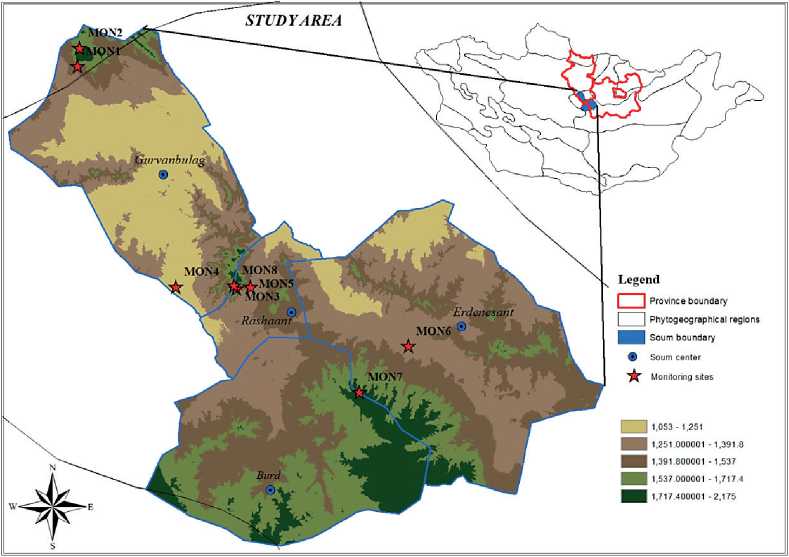
Figure 1. Location of the study sites
Two sites in meadow steppe are located at the onward and backward slope of Avzaga mountain with birch forest on peak and another one is located at the onward slope of Khugnukhan mountain with Ulmus groove(elevation ranged 1490–1671 m a.s.l.).Sitesin dry steppe are located at plateau between these mountains with elevation ranged 1203–1375 m a.s.l. (Table 1). All sites are belonging to Middle Khalkhaand Khangaiin accordance withphytogeographical regions of Mongolia (Grubov, 1982).
Sampling and measurement. Danzhalova et al. [2011] described species diversity and composition, total coverage, aboveground biomass of plant communities and indicator species distribution as key indicators to determine stages of land degradation [Danzhalova et al., 2011; Bunning et al., 2016]. We assumed changes in vegetation cover, species composition, ecological group, phytocenosis origin of plant species and species diversity as main indicator of land degradation.
Table 1
Position and characteristic of all eight sites in Bulgan and Tuv province
|
Sites |
Geographic location |
Community |
Comments |
|
MON1 |
N48°00’08.1», E103°12’50.1», 1480 m a.s.l. |
Meadow steppe |
It locates at 15° south slope of Avzaga mountain in Gurvanbulag, Bulgan province |
|
MON2 |
N48°02’42.5», E103°13’29.2», 1671 m a.s.l. |
Meadow steppe |
It locates at 25° north slope of Avzaga mountain in Gurvanbulag, Bulgan province |
|
MON3 |
N47°27’11.5», E103°43’36.8», 1450 m a.s.l. |
Meadow steppe |
It locates at gully with Ulmus groove in Khugnu-Tarna National Park, Bulgan province |
|
MON4 |
N47°27’57.3», E103°30’53.8», 1189 m a.s.l. |
Steppe |
It is located at downhill to Tarna river, observed greatly grazing effect and flooding water when intense rain |
|
MON5 |
N47°27’20.7», E103°46’31.2», 1378 m a.s.l. |
Steppe |
It is located near to cropland at an eastern side of Khugnu-Tarna, Rashaant Bulgan |
|
MON6 |
N47°17’26,6», E104°18’40,9», 1314-1319 m a.s.l. |
Steppe |
It is located at the lower slope of Batkhan mountain in Erdenesant, Tuv province |
|
MON7 |
N47°11’22.9»; E104°07’49.9», 1784 m a.s.l. |
Forest |
The site is located in the Tsuugel pass of Batkhan Mountain with remaining forest distributed in a large area of larch forest. |
|
MON8 |
N47°27’40.7»,E103°43’04.1», 1819 m a.s.l. |
Forest |
The area is located in the upper part of Tsetserleg Mountain’s back slope of the Khugnukhan mountain peak with Siberian pine. |
Each 20m x 20m area was marked with sticks at the four corners of the survey area. The study area had been monitored without fenceunder human and natural impacts. In dry steppe, study work was conducted in 2011–2015, while 2012–2015 in meadow and forest steppe. Fieldwork used to carry out from the end of July till the 10th of August every year and we recorded number of plant species at marked areas and projective coverageat 1m x 1m quadrat separately for each species. To illustrate community structure change, we distinguished community main species and digression species. Main plant species are defined as species most commonly or conspicuously found in a particular unaffected community. Under reserved conditions Stipa krylovii, Stipa sibirica and Festuca sibirica are dominant species in the mountain-meadow steppe communities; Stipa baicalensis and Allium senescens dominate in meadow steppe; Stipa baicalensis and Stipa krylovii are edificators in true steppe; Stipa krylovii is common in dry steppe [Bazha et al., 2012]. According to Lavrenko et al. [1991] steppes are formed by herbaceous communities with the dominance of tussock species, mainly consist of large and small tussock grasses from the genera Stipa, Festuca, Agropyron, Koeleria, Cleistogenes, Helictotrichon and less commonly composed of sedges (Carex) and onions (Allium).We identified plant species including Artemisia frigida, Artemisiaadamsii, Caragana microphylla, Caraganastenophylla, Cleistogenes squarrosa, Convolvulus ammanii, Elymus chinensis, Panzera lanata, Potentilla bifurca, Potentillaacaulis, Salsola collina, Carex duriuscula, Veronica incana, Urtica cannabina as indicator of land degradation in meadow steppe, steppe and forest area based on our observation and former research results [Lavrenko et al., 1991; Chognii, 2001; Tserenbaljid, 2002; Gunin et al., 2013; Tuvshintogtokh, 2014].
During the data analysis, each species was divided into the ecological groups, which are described by Ulziikhutag (1989).This classificationcategorized plant species into 19 groups (xerophyte, meso-xerophyte, mesophyte, meso-hygrophyte, hygrophyte, xero-hygrophyte, hydrophyte, psychrophyte, meso-psychrophyte, hygro-psychrophyte, meso-petrophyte, xero-petrophyte, psychro-petrophyte, halophyte, xero-halophyte, mesohalophyte, psammo-halophyte, psammophyte, oxylophyte) by ecological characteristic, especially water use. Phytocenosis origin is more like associated with plant species adaptation to habitat or phytocenosis; species were divided into groups such as plants from meadow, meadow steppe, steppe, mountain steppe,and desert steppe.
Projective cover of main and digression species was transformed to proportion in total cover in order to illustrate fairly change of species participation in community. All statistical analyses and graphics were performed using R 3.6.3 for Windows [Jari et al., 2019]. We used the Shannon diversity indices in our study. Formula is:
н = -Zf=iPiiog(b)pj (1)
Pi — is the proportional abundance of species i b — is the base of the logarithm
Results
We recorded 178 species belonging to 125 genera, 39 families throughout study area during all study year. Xerophytes, distributed water deficient area such as steppe and desert, mesophytes, are adapted to habitat with plenty of water and high soil nutrient, meso-xerophytes, are regularly water deficient in meadow steppe, xero-mesophytes, psammophytes, distributed on sand dune and sandy soil and halophytes, adapted to habitat with salt marsh were recorded commonly during our research. Species composition consisted of prevalently xerophyte and meso-xerophyte (44.8%), mesophyte and xero-mesophyte (27.5% and 15.7%, separately), petrophyte (10%) and psammophyte and halophyte species constituted only 1% respectively.
Species richness and composition change. Change in species number illustrated in Table 2.
Table 2
Species number of vegetation communities in mountain meadow steppe and dry steppe
|
Mon1 |
Mon2 |
Mon3 |
Mon4 |
Mon5 |
Mon6 |
|
|
2011 |
12 |
25 |
20 |
|||
|
2012 |
34 |
39 |
39 |
11 |
20 |
18 |
|
2013 |
25 |
23 |
30 |
6 |
18 |
8 |
|
2014 |
26 |
17 |
22 |
8 |
11 |
8 |
|
2015 |
23 |
15 |
19 |
10 |
13 |
15 |
MON1: Small graminoid — Filifolium sibiricum — Stipa krylovii with Amygdalus pedunculata meadow steppe. We recorded total 51 species all study year. Species number decreased 34 to 23 during research year. Total 9 plant species such as Amygdalus pedunculata, Agropyron cristatum, Cleistogenes squarrosa, Haplophyllum dauricum, Pulsatilla bungeana, Saussurea salicifolia, Stellera chamajasme, Iris tigridia, Serratula centauroides were recorded in some extent during all research year in this meadow steppe. Species including Convolvulus ammanii, Sibbaldianthe adpressa, Potentilla bifurca, Salsola collina, Caragana microphylla had recorded while species such as Atraphaxis frutescens, Carum buriaticum, Caryopteris mongolica, Gentiana decumbens, Linaria acutiloba, Potentilla sericea had not recorded since 2013.
MON2: Forbs — small graminoid — Stipa baicalensis meadow steppe with 46 species. Main dominant species were Stipa baicalensis, Stipa krylovii , and subdominants are small gramineum such as Festuca and Poa including Carex pediformis . Regular abundant forb species were Echinops latifolius, Potentilla acaulis, Stellera chamaejasme and few shrubby cinquefoils. Number of species decreased from 39 to 15 between 2012 till 2015. Thermopsis dahurica, Carex duriuscula mounted in the community, but several species including Helictotrichon schellianum, Stipa baicalensis, Amblynotus rupestris, Chamaerhodos altaica, Cymbaria dahurica, Dianthus versicolor, Galium boreale, Galiumverum, Scabiosa comosa were expelled from community.
MON3: Artemisia dracunculus — Stipa krylovii — Ulmus grove with 55 plant species. Main dominant species were Stipa krylovii, Artemisia dracunculus, Artemisiafrigida and perennial forbs — Spiraea aquilegifolia, Potentilla acaulis, Thermopsis lanceolata, Agropyron cristatum, Caragana microphylla were recorded permanently in certain coverage. We found 4 shrubs, 3 semi shrubs and 1 tree species in this site. Species number decreased 39 to 19. Festuca lenensis, Koeleria macrantha, Carex pediformes, Allium anisopodium, Dianthus versicolor excluded from community. Dwarf ulmus ( Ulmus pumila ) formed grove and counted 12 shrubs in 100 m2 area. The largest diameter measured with 63 cm.
MON4: Elymus chinensis — Carex duriuscula — Artemisia adamsii steppe. Total of 16 species were recorded during all study year. Main dominant species was Artemisia adamsii and Artemisia frigida , Carex duriuscula, Elymus chinensis were used to record always in all research year. Species number was 6–12 and Agropyron cristatum, Allium bidentatum, Ajania achilloides, Iris lactea didn’t record in some year.
MON5: Artemisia frigida — Cleistogenes squarrosa — Stipa krylovii steppe. 32 species were recorded in all study year and dominant species was Stipa krylovii. Species number decreased 25 to 13. Potentilla acaulis, Cargana microphylla were noted firstly in 2012 and some species such as Galium verum, Dianthus versicolor, Thermopsis dahurica, Veronica incana, Veronica innata were not recorded again in this site from 2012.
MON6: Artemisia adamsii — Stipa krylovii steppe. 28 species were recorded through study years. Main dominant species was Stipakrylovii and decrease in species number was observed. Since 2015, digression species like Allium bidentatum, Chenopodium album , Caragana stenophylla, Astragalus adsurgens were recorded first time in spite of Ptilotrichum canescens, Potentilla bifurca, Silene repens, Taraxacum officinale excluded from this community since 2012.
Vegetation covers in mountain meadow steppe and dry steppe. Vegetation coverage ranged 28.1–61.1% in Avzaga and 53–99.1% in Khugnu Khan mountain meadow-steppe while 25–58.7% in dry steppe (Table 3).
Table 3
Vegetation cover change of study sites in mountain meadow steppe and dry steppe
|
Mon1 |
Mon2 |
Mon3 |
Mon4 |
Mon5 |
Mon6 |
|
|
2011 |
- |
- |
- |
55.5 |
38.3 |
24.8 |
|
2012 |
44.9 |
32.3 |
94.1 |
36.3 |
27.5 |
56.7 |
|
2013 |
56.9 |
48.7 |
99.4 |
43 |
54.4 |
58.7 |
|
2014 |
30.5 |
44.6 |
53.4 |
51.3 |
40.3 |
50 |
|
2015 |
28.1 |
61.1 |
96.3 |
33.7 |
49.9 |
45.6 |
Vegetation cover tended to decrease at 2 sites of mountain meadow and a site of dry steppe while to increase from 32.3-61.1% at a site located north slope of Avzaga mountain (MON2). In addition, we illustrated tendency to increase in cover at 2 sites of dry steppe (Figure 2).
We classified plant species as main, digression and others in order to explain change in cover.
MON1: This meadow steppe’s main dominant species were Stipa krylovii , Filifolium sibiricum and subdominants were small grasses such as Agropyron cristatum, Cleisto-genes squarrosa and perennial forbs constituted in little coverage in this community. Cover of main species ( Agropyron cristatum, Stipa krylovii, Filifolium sibiricum ) was 49.9% of total coverage in 2012 and 63.3% in 2013,cover of S.krylovii increased drastically and 45% in 2014, 40% in 2015 in this site. Cover of main species tend to decrease whereas those of indicator species ( Convolvulus ammanii, Potentilla bifurca, Sibbaldianthe adpressa, Caragana stenophylla, Elymus chinensis, Panzera lanata ) increased gradually (p=0.008, Figure 3).
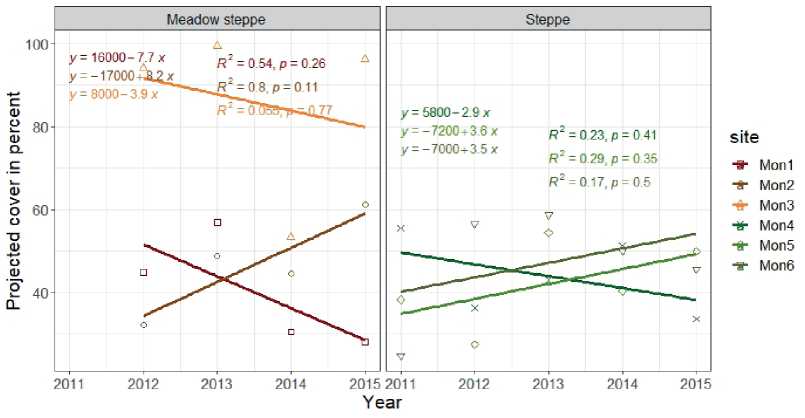
Figure 2. Vegetation cover change in communities
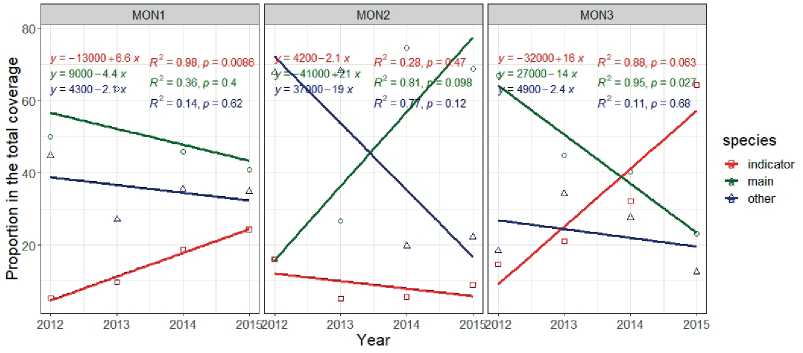
Figure 3. Cover of indicator species in meadow steppe sites
MON2: Main ( Stipa baicalensis, Stipa krylovii, Poa attenuate, Agropyron cristatum, Festuca lenensis, Carex pediformes ) and indicator species comprised equally 16.1% of total vegetation coverage in 2012. Result revealedthat increasing in cover of main species which was 16.1% in 2012, 26.7% in 2013, 74.7% in 2014, and 68.7% in 2015 separately. This rise associated with increasing cover of Stipa krylovii in 2014 and Echinops latifolius, its coverage was remarkably high or 20% of 61.1% in 2015. In addition, cover of S. baicalensis decreased (2%) whereas this of Koeleria macrantha increased drastically (8%) and cover of forbs including Aster alpinus, Echinops latifolius, Galium boreale, Galium verum increased in 2013. Main species cover had increased last two year and other species cover drastically decreased.
MON3: For this meadow steppe, vegetation coverage was higher than other sites. Main species cover decreased year to year (p=0.03). Especially cover of Stipa krylovii was 20%, 2%, 1.5%, 2% in 2012-2015 respectively. Vice versa indicator species cover had continuously increased from 16.6%, 21%, 32%, 64% in proportion of total coverage during all research year. This rise related to covers of Potentilla acaulis, Artemisia frigida, Carex duriuscula and comprised 60% of the total coverage in last year.
MON4: Dominant species was Artemisia adamsii and Artemisia frigida , Carex duriuscula, Elymus chinensis used to record in all research year. These species that indicate land degradation and desertification comprised 67–93% of the total vegetation coverage. Especially, covers of Artemisia adamsii, Elymus chinensis increased drastically in some year. Artemisia frigida and Caragana stenophylla were recorded in 1–4% coverage during all study year. Main species ( Agropyron cristatum, Stipa krylovii ) of dry steppe were occupied only 2.7%, 12.4%, 2.3%, 1.9%, 7.4% of the total coverage 2011–2015 respectively. Agropyron cristatum hadn’t recorded since 2012.
MON5: Dominant species was Stipa krylovii and main species cover decreased from 40% to 28% 2011–2015. There was observed increasing trend of indicator species, for instance, covers for Artemisia frigida and Cleistogenes squarrosa were increased and Potentilla acaulis, Caragana microphylla were noted firstly whereas some other species ( Galium verum, Dianthus versicolor, Thermopsis dahurica, Veronica incana, V. innata ) were not recorded again in this site from 2012. Cover of other species decreased gradually from 8 to 0.8% in last 3 study year (p=0.007).
MON 6: Vegetation coverage tended to increase and main dominant species was S.krylovii .Digression species and main species alternated, cover of digression species reached 59-61% of total coverage in some year, but main species cover reached 62–68%. Cover of Artemisia adamsii , one of indicator species had increased year to year. Other species cover decreased slightly due to removal of some plant species.
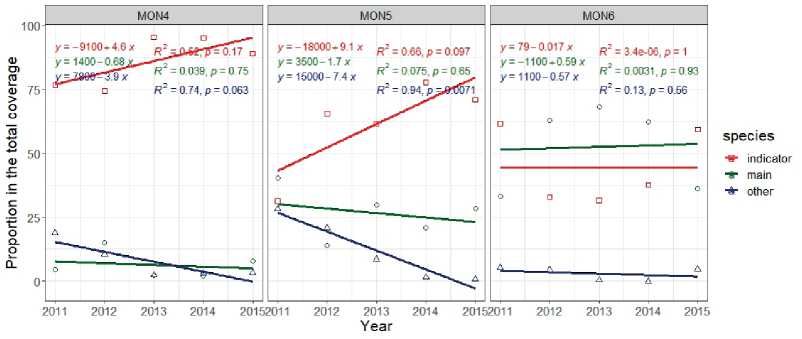
Figure 4. Cover of indicator species in dry steppe sites
For all three sites of meadow steppe, species cover originated from mountain steppe and meadow steppe tended to decrease whereas those from steppe increaseduring research year.Cover of Filifolium sibiricum and Stellera chamajasme from mountain steppe decreased from 14% to 2% in MON1.Cover of Stipa krylovii, classified into steppe, increased at MON2 from 2013. For MON3, mountain steppe species comprised 1–10% of the total species and meadow steppe vegetation 22–57%, steppe 31–70% according to the phytocenosis (Figure 5).
For sites in steppe community, no significant change was observed except MON5. Cover of species from mountain steppe were declined (p=0.03) while those from steppe were increased (p=0.03) in this community. Steppe species comprised 88–100% of community composition and desert steppe, mountain steppe, and meadow species were recorded but it comprised only 2–5% of vegetation coverage in MON4. Steppe species tended to increase gradually and in some year these species’ coverage comprised 100% of total vegetation coverage. For MON6, cover for meadow steppe species comprised 1–3% of total coverage and those of dry steppe species were 94–98%, 0.5–1.8% for sandy, 0.3–4.5% for mountain steppe species.
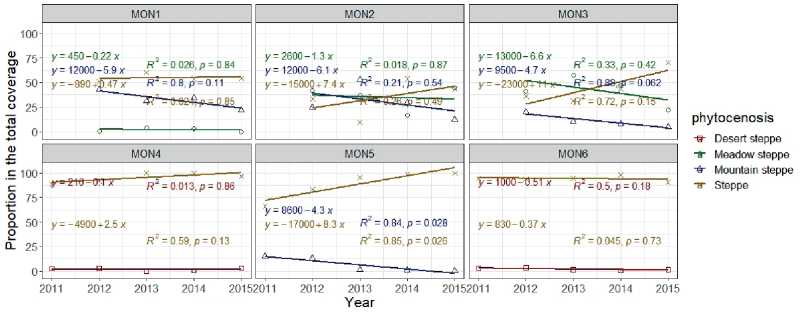
Figure 5. Vegetation cover change in term of phytocenosis
Forest
Carex — Artemisia — Larch forest . Total of 19 families, 45 genus’ 54 species recorded in larch forest. Out of these 4 shrubs and 2 trees ( Larix sibirica, Betula plathyphylla ), 48 species of perennial polycarp plants occur dominant with rhizomatous plants and with 38.8% of grass species out of perennial grasses. The forest is dominant with Larix sibirica, and with very few Betula platyphylla Sukacz. Larch forest’s crown density is 0.7, shrub layers are bush cinquefoil ( Dasiphora fruticosa ), dark fruited shrub ( Cotoneaster melanocarpus ), spiraea ( Spiraea media ), prickly wild rose ( Rosa acicularis ) with large amount of damage and short (20–40 cm) and coverage vary 1–4%. The grass coverage in this area recorded 96.4–96.5% in 2012 and 2013 then in 2014 it decreased nearly 2 times into 53.5%. Plant species’ canopy coverage in 2012 and 2013 comprised 25–40% of mugwort ( Artemisia tanacetifolia ), 5–30% of brome ( Bromus pumpellianus ), 20% of carex ( Carex pediformis ) but it species’ coverage decreased 1–5% in 2014 according to the study.
Mesophyte plants comprise 75.9%, mesoxerophytes 18.5%, and xeromesophytes 5.5% based on ecological community. This indicates that larch forest has sufficient moisture source. Forest plant comprises 44.4%, mountain meadow species 33.3%, meadow steppe 18.5%, mountain steppe 3.7% based on community. The forest remains its taiga larch forest with grass vegetation however, meadow steppe and mountain steppe species are introduced and relatively abundant with mountain meadow species (33.3%). Therefore, it may be assumed that forest area possibly change into mountain meadow, meadow steppe and mountain steppe conditions.
Forbs — Carex — Cedar forest . The cedar forest has total of 30 families, 55 genus’ and 63 plant species. Out of these 2 species of trees, 8 species of shrubs, 1 semi shrub and 2 species of annual monocarp, 52 species of perennial polycarp determined. Dominant species is Siberian cedar ( Pinus sibirica ). Cedar comprises 20% and birch 3% of total coverage. Most of the cedar heights 3–4 m with 12–25 cm diameter and majority of the trees are young with 15cm diameter. Birch ( Betula plathyphylla ) crown density is 0.4 with 1.5–2 m height and tap roots are mainly damaged thus, mostly restored from the stump. Shrub layer was dominant with blue honeysuckle ( Lonicera altaica ) and few Lonicera Microphylla Willa, Sambucus manshurica Kitag. These shrubs seeded efficiently. Common juniper ( Juniperus sibirica ) occurs in few numbers and spiraea ( Spiraea media ), prickly wild rose ( Rosa acicularis ), dark fruited shrubs ( Cotoneaster melanocarpos ) were abundant. Grass vegetation cover is 30–70%, moss — 50%, lichen — 30% (these species usually sealed with each other, so each layer is recorded).
Mesophyte plants are dominant comprise 55.6%, mesoxerophytes are abundant as well with 33.3%, and xero-mesophytes area few 11.1% respectively. Forest vegetation determined with 28.6%, mountain meadow steppe vegetation 27.0%, meadow vegetation 20.6%, mountain steppe vegetation 15.9%. Steppe vegetation recorded only with 1.6%. Meadow steppe and mountain steppe plant species comprise dominant (42.9%) percentage even though; cedar forest is distributed in moist cool part of the Khugnukhan Mountain. It is it feasible to assume that the area is under the beginning of succession phase that changes into meadow steppe passing through mountain meadow and later on forest originating cedar abandoned forming mountain steppe.
Species diversity
Diversity indices were 1.9–2.9 at meadow steppe, 0.8–2.5 at dry steppe and 1.6–4 at forest. Diversity at all sites tended to decrease, but significant change was detected only in dry steppe (MON5). Because of species number declined and only one species dominated in some communities, this reduction was observed.
Vegetation community change. We marked down changes in vegetation communities in Table 4. Some composition shift had occurred during 2011–2015 .
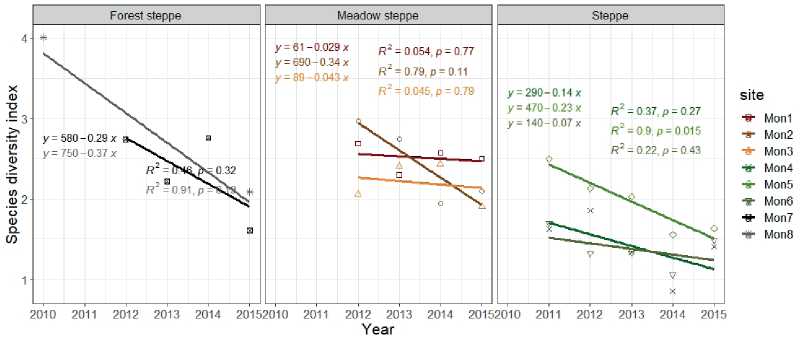
Figure 6. Diversity change in all monitoring sites
Table 4
Composition change in vegetation community during study year.
Name put in first order is dominated species and next one is sub-dominants etc.
Square brackets indicated shrub and tree species occurred in vegetation communities
|
Mon |
2011 |
2012 |
2013 |
2014 |
2015 |
|
1 |
[Amygdalus pedunculata] — Stipa krylovii — Filifolium sibiricum — Cleistogenes squarrosa |
[Amygdalus pedunculata] — Stipa krylovii — Agropyron cristatum — Filifolium sibiricum |
[Amygdalus pedunculata] — Stipa krylovii — Filifolium sibiricum — Agropyron cristatum |
[Amygdalus pedunculata] — Stipa krylovii — Filifolium sibiricum — Cleistogenes squarrosa |
[Amygdalus pedunculata] — Stipa krylovii — Caragana stenophylla |
|
2 |
- |
Forb — Stipa baicalensis — Carex korshinskii — small graminoids |
Forb — small graminoids — Stipa baicalensis, krylovii — Koeleria macrantha |
Stipa krylovii — Poa attenuate — small graminoids |
Stipa krylovii — Echinops latifolius — forb — small graminoids |
|
3 |
- |
[Ulmus pumila] — Stipa krylovii — Artemisia dracunculus, santolinifolia — Spiraea aquilegifolia |
[Ulmus pumila] — Artemisia dracunculus — A. frigida — Elymus chinensis |
[Ulmus pumila] — Artemisia dracunculus — A.frigida — Carex duriuscula |
[Ulmus pumila] — Carex duriuscula — Artemisia dracunculus — A. frigida |
|
4 |
Forb — Artemisia adamsii — Carex duriuscula |
Artemisia adamsii — Elymus chinensis — Carex duriuscula |
Artemisia adamsii — Elymus chinensis — Carex duriuscula |
Artemisia adamsii — Elymus chinensis — Carex duriuscula |
Artemisia adamsii — Elymus chinensis — Carex duriuscula |
|
5 |
Forb — Stipa krylovii Elymus chinensis — Cleistogene squarrosa |
Forb — Artemisia frigida — Stipa krylovii — Elymus chinensis — Cleistogene squarrosa |
Forb — Artemisia frigida — Stipa krylovii — Cleistogene squarrosa — Elymus chinensis |
Artemisia frigida — Cleistogene squarrosa — Stipa krylovii |
Artemisia frigida — Stipa krylovii — Cleistogene squarrosa — Caragana microphylla |
|
6 |
Stipa krylovii» — Elymus chinensis — Artemisia adamsii |
Stipa krylovii — Artemisia adamsii — Elymus chinensis |
Stipa krylovii — Elymus chinensis — Artemisia adamsii |
Stipa krylovii — Artemisia adamsii |
Artemisia adamsii — Stipa krylovii |
Continuation of Table 4
|
Mon |
2011 |
2012 |
2013 |
2014 |
2015 |
|
7 |
- |
[Larix sibirica, Betula plathyphylla] — Forb — Artemisia tanacetifolia — Bromus inermis |
[Larix sibirica, Betula plathyphylla] — Forb — Artemisia tanacetifolia — Carex pediformes |
[Larix sibirica, Betula plathyphylla] — Graminoid — Artemisia tanacetifolia |
[Larix sibirica, Betula plathyphylla] — Carex pediformes — Artemisia tanacetifolia |
|
8 |
- |
[Pinus sibirica, Betula plathyphylla, Larex sibirica] — forb — graminoid — Selaginella sanguinolenta |
[Pinus sibirica, Betula plathyphylla, Larex sibirica] — forb — graminoid — Selaginella sanguinolenta |
[Pinus sibirica, Betula plathyphylla, Larex sibirica] — forb — graminoid — Selaginella sanguinolenta |
[Pinus sibirica, Betula plathyphylla, Larex sibirica] — forb — graminoid — Selaginella sanguinolenta |
Discussion
The assessment of desertification vulnerability to climate change and human induced impact is important to assist decision-makers develop the best plan for land rehabilitation and combat global desertification in sensitive areas [Huang et al., 2020].
Plant coverage in mountain-meadow steppe decreased in 2 sites whereas those of digression species increased (p=0.008, 0.02), but main species of this sites diminished. Covers for Caragana stenophylla, C. microphylla had increased gradually in little amount for south slope site and Carex duriuscula, Artemisia frigida encroached considerably at Ulmus groove. Communities dominated by Carex grow on soils of light mechanical composition with a small content of humus [Zharnikova et al., 2018]. Vegetation coverage of meadow steppesite located at north slope of mountain was increased associated with main species projected cover such as Stipa krylovii and Echinops latifolius as well as other species including Agropyron cristatum, Poa attenuata, Stelleria chamaejasme. Echinops latifolius outbreak happened in 2015, so it may seeds were deposited in soil, as soon as develop favorable condition, it can readily grow in this site. Diversity of this site tended to decrease, but not observed in other 2 sites. In addition, we perceived cover of mountain steppe species were diminished and increased cover of steppe species at three sites of mountain-meadow steppe. In other words, community change is occurring. Same research result in Darkhan was illustrated that dominants are replaced by subdominants and semi-shrubs like Caragana pygmaea, C. microphylla and Artemisia frigida increased in community [Bazha et al., 2012]. Community carried [Amygdalus pedunculata] — Stipa krylovii — Filifolium sibiricum — Cleistogenes squarrosa at mountain-meadow steppe in 2011 and it transformed to [Amygdalus pedunculata] — Stipa krylovii — Caragana stenophylla in 2015, [Ulmus pumila] — Stipa krylovii — Artemisia dracunculus, santolinifolia — Spiraea aquilegifolia community transformed to [Ulmus pumila] — Carex duriuscula — Artemisia dracunculus — A. frigida. For community carried Forb — Stipa baicalensis — Carex korshinskii — small graminoids, coverage increased varied dominant species in every year and it transformed to Stipa krylovii — Echinops latifolius — forb — small graminoids.
We didn’t observe reduction in projected coverin all three sites of steppe, only in one site, conversely vegetation coverage increased in 2 study sites. For steppe, vegetation cover increase was related with digression species expansion. Cover of Artemisa adamsii , A. frigida were increased gradually in little amount every year. Covers for main and other forbs were decreased. The studies on the steppe ecosystems in Central Mongolia showed that, over the past decades, the simplification of the structure of steppe communities took place. It occurred by reduction of the species diversity and abundance of native dominant species of these steppes, tussock grasses, up to their complete disappearance from grass stands as a result of a sharp increase in pasturing load and long dry periods [Bazha et al., 2015]. Species number and diversity were reduced and this may explained by few species dominance, lost evenness. According to research results in Central Mongolia, dominance of Ephedra sinica and Allium polyrrhizum have been formed in vast areas in dry steppe [Bazha et al., 2015] and the replacement of typical grass species of dry steppes ( Stipa krylovii , Agropyron cristatum , Cleistogenes squarrosa , and Koeleria cristata ) with desert-steppe species ( Allium polyrrhizum ) was noted; in addition, there was a significant decrease in the role of grass species ( Stipa glareosa , Cleistogenes soongorica ) in the community structure and an increase in the proportion of desert shrubs [Gunin et al., 2019]. Our research results allowed that in most of study sites, cover of main species tended to invaded by digression species including Artemisiafrigida , A. adamsii, Caragana microphylla . In 2011, community carried Forb — Artemisia adamsii — Carex duriuscula turned into Artemisia adamsii — Elymus chinensis — Carex duriuscula which forb species cover decreased. Community carried Forb — Stipa krylovii — Elymus chinensis — Cleistogene squarrosa changed to Artemisia frigida — Stipa krylovii — Cleistogene squarrosa — Caragana microphylla . Community with Stipa krylovii — Elymus chinensis — Artemisia adamsii transformed into Artemisia adamsii — Stipa krylovii in 2011–2015.
According to research results in mountain-meadow steppe, meadow steppe, true steppe, dry steppe and desert steppe community in Mongolia, cover and total aboveground phytomass were reduced and species composition changed that semibush, bushes became dominant, community was transformed into another community, but in some instance, cover was increased due to an increase of bushes and digression species in certain community [Bazha et al., 2012]. The increase in the aridity of climate is manifested in a gradual decrease in the projective cover of the plant communities [Zharnikova et al., 2018]. The results show that projective cover do notalways respond to anthropogenic disturbance and does not always correspond to actual state of plant communities [Danzhalovaet al., 2011].
Conclusion
Biological-ecological and community study in selected monitoring sites indicated possibility of community transformation occurred in our study area, mountain-meadow steppe change into mountain steppe, steppe to dry steppe. Comparative monitoring study on birch forest indicates that Khugnukhan Mountain birch forest has been shifting into the mountain steppe and Batkhan mountain birch forest can be recovered, but it is also at risk of changing into mountain meadow steppe. This relates with climate change and drought occurrence. We considered species number, projected cover, and diversity index as indicator of land degradation. But cover couldn’t indicate vegetation degradation, because of increase in cover mostly related to digression species overgrowth. It is more meaningful to prefer composition in vegetation communities and their change.
Список литературы Vegetation monitoring results of mountain-meadow steppe, steppe and forest area in Mongolia
- Bazha S. N., Bayasgalan D., Gunin P. D., Danzhalova E. V., Drobyshev Yu. I., Kazantseva T. I., Prishchepa A. V & Khadbaatar S. (2008). Specific features of pasture digression of steppe ecosystems of Central Mongolia. Botanical Zhurnal, 93(5): 657-681.
- Bazha S. N., Gunin P. D., Danzhalova E. V., Drobyshev, Y. I. & Prishcepa A. V. (2012). Pastoral degradation of steppe ecosystems in Central Mongolia. Eurasian Steppes. Ecological problems and livelihoods in a changing world. Springer, Dordrecht, pp. 289-319.
- Bazha S. N., Gunin P. D., Danzhalova E. V., Drobyshev Y. I., Kazantseva T. I., Ariunbold E., Myagmarsuren D., Khadbaatar S.& Tserenkhand G. (2015). Invasive successions as the indicator of desertification of dry steppe by way of example of Central Mongolia. Russian Journal of Biological Invasions, 4(6): 223-237.
- Bulgamaa D., Sumjidmaa S., Brandon B.& Budbaatar U. (2018). National Report on the Rangeland Health of Mongolia: Second Assessment. Ulaanbaatar, pp. 16. (In Mongolian).
- Bunning S., McDonagh J., Rioux J., Nachtergaele F., Biancalani R. and Woodfine A. C. (2016). Land Degradation Assessment in Drylands: manual for local level assessment of land degradation and sustainable land management. Part 2. Food and Agriculture Organization of the United Nations, Rome, pp. 39- 65.
- Chognii O. (2001). Characteristic of change and restoration of degraded pasture in forest steppe and steppe zone in Mongolia. Ulaanbaatar, pp. 179-300.
- Danzhalova E. V., Bazha S. N. & Ariunbold E. (2011). The Structure of Plant Communities in the Dry Steppes of Central Mongolia and their Response to Irrigation. Arid Ecosystems, 1(3): 171-176.
- Grubov V. I. (1982). Key to the Vascular Plants of Mongolia. Leningrad, Nauka, pp. 442. (in Russian).
- Gunin P. D., Dedkov, V. P., Danzhalova, E. V., Bazha, S. N., Zolotokrylin A. N. & Kazantseva T. I. (2019). NDVI for Monitoring of the State of Steppe and Desert Ecosystems of the Gobi. Arid Ecosystems, 9(3): 179-186.
- Gunin P. D., Bazha S. N., Danzhalova E. V., Drobyshev Yu. I., Kazantseva T. I., Tserenkhand G. & Khadbaatar S. (2013). Present Invasive Successions in Dry Steppe Communities of Central Mongolia. Proc. Int. Conf. "Plant Biodiversity and Ecosystem Services in Continental Asia", Ulaanbaatar, pp. 54-56.
- Huang J., Zhang G., Zhang Y., Guan X., Wei Y. & Guo, R. (2020). Global Desertification Vulnerability to Climate Change and Human Activities. Land Degradation & Development, 31(11): 1380-1391.
- Jari Oksanen, F. Guillaume Blanchet, Michael Friendly, Roeland Kindt, Pierre Legendre, Dan McGlinn et al. (2019). Vegan: Community Ecology Package. R package version 2.5-6. Available at: https://CRAN.R-project.org/package=vegan (accessed 12.03.2022)
- Lavrenko E. M., Karamyshev Z. V, Nikulina R. I. 1991. The Eurasian Steppes. Leningrad, Russia, pp.144.
- Mandakh N., Qi Feng & Ravinesh Deo. (2018). A comparative Study of Temperature and Precipitation-Based Aridity Indices and Their Trends in Mongolia. International Journal of Environmental Research, 12: 887-899.
- Natsagdorj L. & Gomboluudev P. (2015). Climate Change and Desertification. Ecosystems of Central Asia under Current Conditions of Socio-Economic Development. Proc. International Conference, 2: 390-392.
- Natsagdorj L. & Altantsetseg Kh. (2008). Some Study Results on Change of Summer Rainfall Duration over Mongolian Territory. Regional Climate Change of Western Region, Compiled Proceeding, Uliastai.
- Natsagdorj L., Munkhbat B. & Gomboluudev P. (2019). Climate Biocapacity of Mongolia and its Change. Proceedings of the Mongolian Academy of Sciences, 59(2): 54-70.
- Tuvshintogtokh I. (2014). Vegetation of Mongolian steppe. Ulaanbaatar, pp. 42-47.
- Tserenbaljid G. (2002). Photos of Weeds Distributed in Mongolia. Admon print, Ulaanbaatar.
- Ulziikhutag N. (1989). Floral outline of Mongolia. Mongolian State Publ., Ulaanbaatar, pp. 15.
- Vandandorj S., Munkhjargal E., Boldgiv B. & Gantsetseg B. (2017). Changes in Event Number and Duration of Rain Types over Mongolia from 1981 to 2014. Environmental Earth Sciences, 76(2): 70.
- Zharnikova M. A., Alymbaeva, Z. B., Tsydypov B., Ayurzhanaev A. A., Garmaev E. Z. & Tulokhonov A. K. (2018). The Current State of Steppe Ecosystems in the Arid Zone of Mongolia (a case study of the model site of Mandalgovi). IOP Conference Series: Earth and Environmental Science, 012047-012047.

